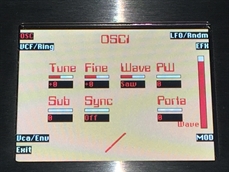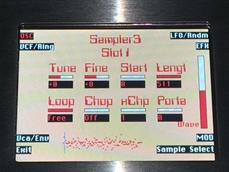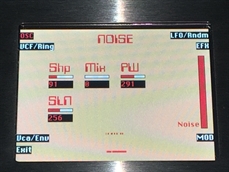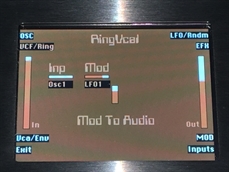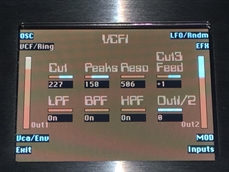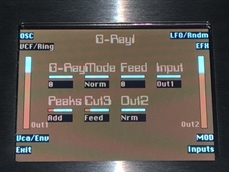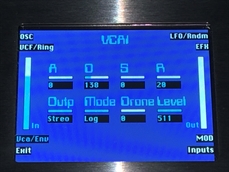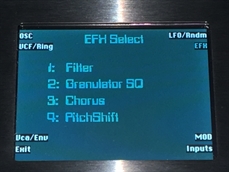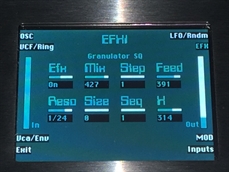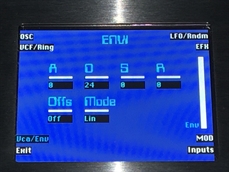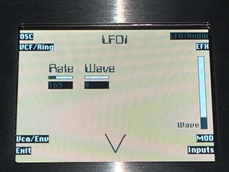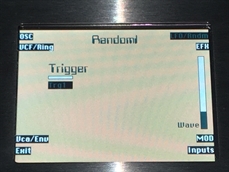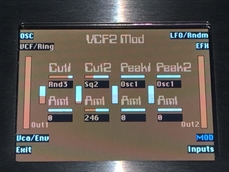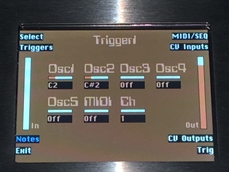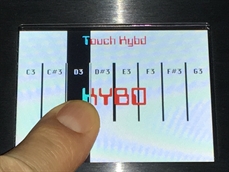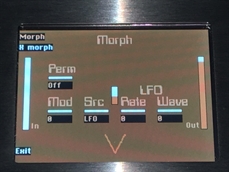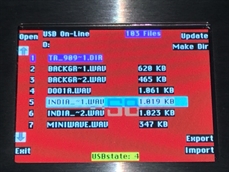Gotharman's Anamono X

Modular synthesizer with memory, 2 swappable analog filters, sampler and granular effects.
Details:
-5 Oscillators/Samplers.
For each of the 5 oscillators, it is possible to select if it should act as an oscillator or a sampler.
In oscillator mode it generates a waveform that is morphable between sine, triangle, saw, pulse and feedback waves. Pulse width are adjustable for all waveform types. Each oscillator also has a suboscillator attached to them, that outputs a squarewave, one octave below the original pitch.
The oscillators outputs both an audio range signal and a low frequency version of this at the same time, so the oscillators can function as both audio range sound/modulation and low frequency modulation, at the same time. Pitch, PW, wave and suboscillator level can be modulated. The oscillators can act as both audio and modulation sources.
In sampler mode it plays back any of the 476 storable samplings. Pitch, start point and length can be adjusted and modulated. Samples are chromatically tuned, and has a pitch range of 4 octaves above and 5 octaves below the original sample pitch. Loop mode can be set to Off, On or Free. In Free mode the sampling is constantly playing back, and is never re-trigged. So if you set it up to go through a VCA, and set this up to be opened by a trigger, a different portion of the sampling will be played back every time the VCA is opened. Samplings can act as both audio and modulation sources. Like the oscillators, the samples also outputs a low frequency version of itself, so samples can be used as low frequency modulation too.
Sampler modules can load and playback Little deFormer samples and use the chop points. It is also possible to create chop points in the anAmoNo X sample editor, and use these. Chops can be detected by level peaks or by single wavecycles, and multiple wav files can be imported as one sampling with chop points. Single wavecycle chops are an easy way to make loops.
Both oscillators and samplers has a portamento control.
-1 Noise Generator.
One Noise Generator is present. The parameters Shape, pulse width and mix (between pulse and voltage noise) can be adjusted and modulated. It outputs to both the audio and the modulation bus, and like the oscillators and samplers, this also outputs a slow version of itself. The rate of the slow wave can be adjusted.
-1 Audio Input.
The audio input shows up as both an audio source and a modulation source, so it can be routed to any module input.
-4 Ring VCA's.
The 4 Ring VCA's has 3 functions. They can act as:
-Ring Modulator -Connect 2 audio sources, and it will output a ring modulated signal.
-Modulation/audio source VCA -Connect an audio or a modulation source to input 1, and a modulation source to input 2, and the modulator on input 2 will adjust the level of the source on input 1.
-Modulation to audio convertor -If you would like, for instance, to route and envelope, LFO or even a sequencer track through effects or filters, you can do this through a Ring VCA.
Ring VCA's outputs to both the audio and the modulation bus.
-2 swappable Analog Filters.
Located in 2 slots, that becomes visible, when removing the left side panel. anAmoNo X will also work, without any analog filters installed.
Different types of analog filters will be available, to mount in the 2 slots.
The analog filters are used just like any other anAmoNo X module. It is possible to route any modulation sources and audio signals to them, and they outputs on both the audio bus and the modulation bus. Cutoff frequency, peaks (space between 2 cutoff frequencies), and resonance can be adjusted and modulated. If the mounted filter has analog feedback, this can also be adjusted and modulated. LPF, BPF and HPF filter modes can be switched on and off. Most filters has 2 audio outputs. The mix between these can be adjusted and modulated. On the first filters, an analog overdrive circuit is placed on output 2, so turning up the Out1/2 knob, will add analog overdrive to the filter sound. The analog filters also has a G-Ray digital/analog feedback circuit attached.
-2 G-Ray feedback circuits.
Located in the analog filters audio chains, the G-ray (Gotharman-Ray) circuits will add grit and noise to any analog filter. The G-ray circuits are placed on the anAmoNo X mainboard, so they will be present, no matter what analog filters you mount. Since this is always connected to an analog filter, audio inputs and modulations are routed through the filter. G-Ray intensity, mode, feedback and input source (Filter out 1,2 or mix) can be adjusted, and feedback can be modulated.
-4 VCA's.
Audio signals can be mixed and routed to output 1 and 2 through these. Output can also be switched off, if you only want to use a VCA for internal audio level modulation. An ADSR envelope are attached to each of the VCA's. The VCA envelopes can either be in linear or logarithmic mode. A Drone parameter are available, for opening the VCA without the envelope needing to be trigged. VCA output level, attack, decay and release can be modulated. The VCA's only outputs to the audio bus. If you need VCA's for modulation signals, you should use a Ring VCA.
-4 Effects Processors.
Effects present at the moment (more might be added):
-Digital filter/EQ - 16 filter types and 2 EQ types. Derived from Fuzion.
-Chorus - Gotharman's special chorus with an added Deep parameter, that adds space to the chorus.
-Pitch-Shifter - +/- 1 octave, +/- 2 octaves or +/- 4 octaves. Adustable sense.
-Stretcher - Tries to time stretch the input signal, while at the same time keeping up with it. Impossible? -Yes, indeed :-)
-FM - Adds self-FM to the input signal in +/- 1 octave, +/- 2 octaves or +/- 4 octaves ranges.
-Resonator - Adds space to the sound.
-Distortions - 4 types: Valve, Sine, Fuzz, Xdis.
-Pitch Shaper 1 and 2 - 1 and 2 input versions of Gotharman's special Pitch Shaper, that forces an audio signal to play back at a specific pitch, determined either by an adjustable frequency, or by the frequency of another audio signal.
-Glitch Shifter 1 and 2 - Imperfect pitch shifters.
-Wave Shaper - Re-shapes the input signal.
-ONLY EFFECT 1 and 2:
-Granulator - Cuts the input signal up in grains, that can be re-arranged. The anAmoNo X granulator can sync to the sequencer.
-Variator. Creates new variations of the input signal. Both pitch and rhythmic variations.
-Delay - Delay with time and feedback controls, plus Gotharman's Deep, Size, Beam and Xfade controls. Deep adds space to the delay, Size makes the playback range more narrow than the input recording range, and beam beams the delay to previously unknown places. The Xfade control on this delay, creates valleys between the delay taps. The more it is turned up, the more time the valleys takes up.
-Roto Delay - New Gotharman delay! This is a 2 tap delay, that is constantly crossfading between the 2 taps. When the Xfade control is turned down, the crossfading is rough, the more it is turned up, the more smooth the crossfading gets. Other controls are the same as the first delay.
-Bright Delay - First delay, but with a brighter sound, created by a resonator.
-Bright Roto Delay - Roto delay, but with a brighter sound, created by a resonator.
-Reverb - Takes up 2 effect slots: 1+3 and/or 2+4.
All effects has a bypass/Freeze switch and a mix parameter. All effects outputs to both the audio and the modulation bus, and many parameters can be modulated.
-8 ADSR Envelopes
4 VCA envelopes and 4 modulation envelopes. With linear/logarithmic charateristics and the modulation envelopes has an offset control.
-4 LFO's.
4 LFO's with continuosly adjustable waveform and rate. Both of these parameters can be modulated.
-4 Random Generators.
Changes to a new random value every time they are trigged. Trigger sources can be trigger 1-8 and LFO 1-4.
-4 CV/trigger inputs.
Accepts up to +/- 15 volts. Internally scalable to work in +/- 12 volts, 0-12 volts, +/- 5 volts or 0-5 volt ranges. Intput sample rate: 5 KHz.
-4 CV/trigger ouputs (optional).
Can output all modulation sources and triggers in the range of 0-5 volts. Output sample rate: 22 KHz.
-8x 64-step Note sequencers with MIDI Out.
-16x 64-step control sequencers with MIDI Out.
Connecting modules:
Most modules has a "Mod" page and an "Inputs" page.
On the "Mod" page you can select any module output, to modulate the selected parameter, and adjust the modulation intensity.
On the "Inputs" page, you can select 4 audio outputs from any modules, to be mixed into the selected module. Mix levels can also be adjusted.
If you would like to use a modulation only sources in the audio chain, you must assign this to a Ring VCA input, and then select this Ring VCA as the audio input source.
On all modules, that has an input, the level of the input to the module is shown as a large VU-meter in the left side of the screen. The output of the module is shown as a large VU-meter in the right side of the screen. The state of the selected modulation sources or the level of the selected audio input sources, are shown as small VU-meters , next to the parameters.
It is as easy as that. No physical cables or computers needed :-)
Trigger System:
-The 8 pushbuttons on anAmoNo X will function as trigger buttons, when the "Triggers" button is activated.
For each trigger button it is possible to:
-Select up to 8 modules, that it should trigger.
-Send specific notes to the oscillators and samplers.
-Select a specific MIDI note range and a transpose value. The MIDI input goes through the trigger system, and MIDI notes will make the triggers play back according to these settings.
-Each trigger button has one Sequencer note track attached to them. Each sequencer note track has 4 subtracks: Note on/off track, note number track, gate length tracks and delay track. Each subtrack has adjustable length on up to 64 steps and adjustable resolution.
Touch Screen Keyboard:
-Included!
Morphing System:
-Each preset holds 2 sets of sound parameters. By using the Morph knob, or by assigning modulation to this, it is possible to morph between the 2 sets of parameters. Pushing the "Morph Settings" button on any edit page, will reveal the second set of parameters.
X Morphing System:
-The sequencer also has 2 sets of parameters. Turning the "X" knob will morph between the 2 sets of parameters -Morph from one tune to another.
USB:
-Import/export samples as .wav files. and multiple samples as one sampling with chop points
-Import/export presets as .axp files.
-Backup/restore of anAmoNo X’s user memory.-Updating of firmware.
Presets:
-Holds 1024 user re-writable presets (not all presets are pre-programmed).
Songs:
-Holds 1024 user-writable songs, with each 128 song steps.
Sampler:
-Samples are kept in NOR FLASH RAM, that is much more stable than the widely used NAND FLASH, and that does not get any bad blocks.
-Samples are kept even after a power off.
-Total recording time: 47 minutes mono. Bank A: 21 minutes, Bank B 27 minutes.
-Single sampling max length: 27 minutes.
-Max. 220 samplings in Bank A and 256 samplings in Bank B. Total 476 samplings.
-Recording sources: Audio input, audio output, USB import of .wav files.
Connections:
-Audio In.
-Audio Out x2. -2x mono or Stereo. A pair of stereo headphones can be connected to Output 1.
-4 x CV/trigger Inputs. Accepts up to +/- 15 volts. Internally scalable to work in +/- 12 volts, 0-12 volts, +/- 5 volts or 0-5 volt ranges. Minijacks. Intput sample rate: 5 KHz.
-4 x CV/trigger Outputs. Range: 0-5 volts. Can output all modulation sources and triggers. Minijacks. Output sample rate: 22 KHz.
-MIDI In.
-MIDI Out.
-USB Drive.
-Power connector.
Audio system:
-Inputs and outputs: 24 bit, 44.1 KHz Cirrus Logic high end ADC/DAC.
-Internal: 32 bit, 44.1 KHz.
-Sampler: 16 bit, 44.1 KHz.
Display:
-Industrial grade 3.2" colour TFT, made in germany.
Power Supply:
-Multi voltage input. Output: 9Vdc, 2A, 2.1mm DC plug with positive middle. Exchangable mains plug, so it can be used in any country.
Size:
23 x 16 x 6 cm
Weight:
1.3 KG
For each of the 5 oscillators, it is possible to select if it should act as an oscillator or a sampler.
In oscillator mode it generates a waveform that is morphable between sine, triangle, saw, pulse and feedback waves. Pulse width are adjustable for all waveform types. Each oscillator also has a suboscillator attached to them, that outputs a squarewave, one octave below the original pitch.
The oscillators outputs both an audio range signal and a low frequency version of this at the same time, so the oscillators can function as both audio range sound/modulation and low frequency modulation, at the same time. Pitch, PW, wave and suboscillator level can be modulated. The oscillators can act as both audio and modulation sources.
In sampler mode it plays back any of the 476 storable samplings. Pitch, start point and length can be adjusted and modulated. Samples are chromatically tuned, and has a pitch range of 4 octaves above and 5 octaves below the original sample pitch. Loop mode can be set to Off, On or Free. In Free mode the sampling is constantly playing back, and is never re-trigged. So if you set it up to go through a VCA, and set this up to be opened by a trigger, a different portion of the sampling will be played back every time the VCA is opened. Samplings can act as both audio and modulation sources. Like the oscillators, the samples also outputs a low frequency version of itself, so samples can be used as low frequency modulation too.
Sampler modules can load and playback Little deFormer samples and use the chop points. It is also possible to create chop points in the anAmoNo X sample editor, and use these. Chops can be detected by level peaks or by single wavecycles, and multiple wav files can be imported as one sampling with chop points. Single wavecycle chops are an easy way to make loops.
Both oscillators and samplers has a portamento control.
-1 Noise Generator.
One Noise Generator is present. The parameters Shape, pulse width and mix (between pulse and voltage noise) can be adjusted and modulated. It outputs to both the audio and the modulation bus, and like the oscillators and samplers, this also outputs a slow version of itself. The rate of the slow wave can be adjusted.
-1 Audio Input.
The audio input shows up as both an audio source and a modulation source, so it can be routed to any module input.
-4 Ring VCA's.
The 4 Ring VCA's has 3 functions. They can act as:
-Ring Modulator -Connect 2 audio sources, and it will output a ring modulated signal.
-Modulation/audio source VCA -Connect an audio or a modulation source to input 1, and a modulation source to input 2, and the modulator on input 2 will adjust the level of the source on input 1.
-Modulation to audio convertor -If you would like, for instance, to route and envelope, LFO or even a sequencer track through effects or filters, you can do this through a Ring VCA.
Ring VCA's outputs to both the audio and the modulation bus.
-2 swappable Analog Filters.
Located in 2 slots, that becomes visible, when removing the left side panel. anAmoNo X will also work, without any analog filters installed.
Different types of analog filters will be available, to mount in the 2 slots.
The analog filters are used just like any other anAmoNo X module. It is possible to route any modulation sources and audio signals to them, and they outputs on both the audio bus and the modulation bus. Cutoff frequency, peaks (space between 2 cutoff frequencies), and resonance can be adjusted and modulated. If the mounted filter has analog feedback, this can also be adjusted and modulated. LPF, BPF and HPF filter modes can be switched on and off. Most filters has 2 audio outputs. The mix between these can be adjusted and modulated. On the first filters, an analog overdrive circuit is placed on output 2, so turning up the Out1/2 knob, will add analog overdrive to the filter sound. The analog filters also has a G-Ray digital/analog feedback circuit attached.
-2 G-Ray feedback circuits.
Located in the analog filters audio chains, the G-ray (Gotharman-Ray) circuits will add grit and noise to any analog filter. The G-ray circuits are placed on the anAmoNo X mainboard, so they will be present, no matter what analog filters you mount. Since this is always connected to an analog filter, audio inputs and modulations are routed through the filter. G-Ray intensity, mode, feedback and input source (Filter out 1,2 or mix) can be adjusted, and feedback can be modulated.
-4 VCA's.
Audio signals can be mixed and routed to output 1 and 2 through these. Output can also be switched off, if you only want to use a VCA for internal audio level modulation. An ADSR envelope are attached to each of the VCA's. The VCA envelopes can either be in linear or logarithmic mode. A Drone parameter are available, for opening the VCA without the envelope needing to be trigged. VCA output level, attack, decay and release can be modulated. The VCA's only outputs to the audio bus. If you need VCA's for modulation signals, you should use a Ring VCA.
-4 Effects Processors.
Effects present at the moment (more might be added):
-Digital filter/EQ - 16 filter types and 2 EQ types. Derived from Fuzion.
-Chorus - Gotharman's special chorus with an added Deep parameter, that adds space to the chorus.
-Pitch-Shifter - +/- 1 octave, +/- 2 octaves or +/- 4 octaves. Adustable sense.
-Stretcher - Tries to time stretch the input signal, while at the same time keeping up with it. Impossible? -Yes, indeed :-)
-FM - Adds self-FM to the input signal in +/- 1 octave, +/- 2 octaves or +/- 4 octaves ranges.
-Resonator - Adds space to the sound.
-Distortions - 4 types: Valve, Sine, Fuzz, Xdis.
-Pitch Shaper 1 and 2 - 1 and 2 input versions of Gotharman's special Pitch Shaper, that forces an audio signal to play back at a specific pitch, determined either by an adjustable frequency, or by the frequency of another audio signal.
-Glitch Shifter 1 and 2 - Imperfect pitch shifters.
-Wave Shaper - Re-shapes the input signal.
-ONLY EFFECT 1 and 2:
-Granulator - Cuts the input signal up in grains, that can be re-arranged. The anAmoNo X granulator can sync to the sequencer.
-Variator. Creates new variations of the input signal. Both pitch and rhythmic variations.
-Delay - Delay with time and feedback controls, plus Gotharman's Deep, Size, Beam and Xfade controls. Deep adds space to the delay, Size makes the playback range more narrow than the input recording range, and beam beams the delay to previously unknown places. The Xfade control on this delay, creates valleys between the delay taps. The more it is turned up, the more time the valleys takes up.
-Roto Delay - New Gotharman delay! This is a 2 tap delay, that is constantly crossfading between the 2 taps. When the Xfade control is turned down, the crossfading is rough, the more it is turned up, the more smooth the crossfading gets. Other controls are the same as the first delay.
-Bright Delay - First delay, but with a brighter sound, created by a resonator.
-Bright Roto Delay - Roto delay, but with a brighter sound, created by a resonator.
-Reverb - Takes up 2 effect slots: 1+3 and/or 2+4.
All effects has a bypass/Freeze switch and a mix parameter. All effects outputs to both the audio and the modulation bus, and many parameters can be modulated.
-8 ADSR Envelopes
4 VCA envelopes and 4 modulation envelopes. With linear/logarithmic charateristics and the modulation envelopes has an offset control.
-4 LFO's.
4 LFO's with continuosly adjustable waveform and rate. Both of these parameters can be modulated.
-4 Random Generators.
Changes to a new random value every time they are trigged. Trigger sources can be trigger 1-8 and LFO 1-4.
-4 CV/trigger inputs.
Accepts up to +/- 15 volts. Internally scalable to work in +/- 12 volts, 0-12 volts, +/- 5 volts or 0-5 volt ranges. Intput sample rate: 5 KHz.
-4 CV/trigger ouputs (optional).
Can output all modulation sources and triggers in the range of 0-5 volts. Output sample rate: 22 KHz.
-8x 64-step Note sequencers with MIDI Out.
-16x 64-step control sequencers with MIDI Out.
Connecting modules:
Most modules has a "Mod" page and an "Inputs" page.
On the "Mod" page you can select any module output, to modulate the selected parameter, and adjust the modulation intensity.
On the "Inputs" page, you can select 4 audio outputs from any modules, to be mixed into the selected module. Mix levels can also be adjusted.
If you would like to use a modulation only sources in the audio chain, you must assign this to a Ring VCA input, and then select this Ring VCA as the audio input source.
On all modules, that has an input, the level of the input to the module is shown as a large VU-meter in the left side of the screen. The output of the module is shown as a large VU-meter in the right side of the screen. The state of the selected modulation sources or the level of the selected audio input sources, are shown as small VU-meters , next to the parameters.
It is as easy as that. No physical cables or computers needed :-)
Trigger System:
-The 8 pushbuttons on anAmoNo X will function as trigger buttons, when the "Triggers" button is activated.
For each trigger button it is possible to:
-Select up to 8 modules, that it should trigger.
-Send specific notes to the oscillators and samplers.
-Select a specific MIDI note range and a transpose value. The MIDI input goes through the trigger system, and MIDI notes will make the triggers play back according to these settings.
-Each trigger button has one Sequencer note track attached to them. Each sequencer note track has 4 subtracks: Note on/off track, note number track, gate length tracks and delay track. Each subtrack has adjustable length on up to 64 steps and adjustable resolution.
Touch Screen Keyboard:
-Included!
Morphing System:
-Each preset holds 2 sets of sound parameters. By using the Morph knob, or by assigning modulation to this, it is possible to morph between the 2 sets of parameters. Pushing the "Morph Settings" button on any edit page, will reveal the second set of parameters.
X Morphing System:
-The sequencer also has 2 sets of parameters. Turning the "X" knob will morph between the 2 sets of parameters -Morph from one tune to another.
USB:
-Import/export samples as .wav files. and multiple samples as one sampling with chop points
-Import/export presets as .axp files.
-Backup/restore of anAmoNo X’s user memory.-Updating of firmware.
Presets:
-Holds 1024 user re-writable presets (not all presets are pre-programmed).
Songs:
-Holds 1024 user-writable songs, with each 128 song steps.
Sampler:
-Samples are kept in NOR FLASH RAM, that is much more stable than the widely used NAND FLASH, and that does not get any bad blocks.
-Samples are kept even after a power off.
-Total recording time: 47 minutes mono. Bank A: 21 minutes, Bank B 27 minutes.
-Single sampling max length: 27 minutes.
-Max. 220 samplings in Bank A and 256 samplings in Bank B. Total 476 samplings.
-Recording sources: Audio input, audio output, USB import of .wav files.
Connections:
-Audio In.
-Audio Out x2. -2x mono or Stereo. A pair of stereo headphones can be connected to Output 1.
-4 x CV/trigger Inputs. Accepts up to +/- 15 volts. Internally scalable to work in +/- 12 volts, 0-12 volts, +/- 5 volts or 0-5 volt ranges. Minijacks. Intput sample rate: 5 KHz.
-4 x CV/trigger Outputs. Range: 0-5 volts. Can output all modulation sources and triggers. Minijacks. Output sample rate: 22 KHz.
-MIDI In.
-MIDI Out.
-USB Drive.
-Power connector.
Audio system:
-Inputs and outputs: 24 bit, 44.1 KHz Cirrus Logic high end ADC/DAC.
-Internal: 32 bit, 44.1 KHz.
-Sampler: 16 bit, 44.1 KHz.
Display:
-Industrial grade 3.2" colour TFT, made in germany.
Power Supply:
-Multi voltage input. Output: 9Vdc, 2A, 2.1mm DC plug with positive middle. Exchangable mains plug, so it can be used in any country.
Size:
23 x 16 x 6 cm
Weight:
1.3 KG


